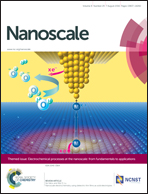In situ and operando atomic force microscopy of high-capacity nano-silicon based electrodes for lithium-ion batteries†
Abstract
Silicon is a promising next-generation anode material for high-energy-density lithium-ion batteries. While the alloying of nano- and micron size silicon with lithium is relatively well understood, the knowledge of mechanical degradation and structural rearrangements in practical silicon-based electrodes during operation is limited. Here, we demonstrate, for the first time, in situ and operando atomic force microscopy (AFM) of nano-silicon anodes containing polymer binder and carbon black additive. With the help of this technique, the surface topography is analyzed while electrochemical reactions are occurring. In particular, changes in particle size as well as electrode structure and height are visualized with high resolution. Furthermore, the formation and evolution of the solid-electrolyte interphase (SEI) can be followed and its thickness determined by phase imaging and nano-indentation, respectively. Major changes occur in the first lithiation cycle at potentials below 0.6 V with respect to Li/Li+ due to increased SEI formation – which is a dynamic process – and alloying reactions. Overall, these results provide insight into the function of silicon-based composite electrodes and further show that AFM is a powerful technique that can be applied to important battery materials, without restriction to thin film geometries.

- This article is part of the themed collection: Electrochemical processes at the nanoscale: from fundamentals to applications

 Please wait while we load your content...
Please wait while we load your content...